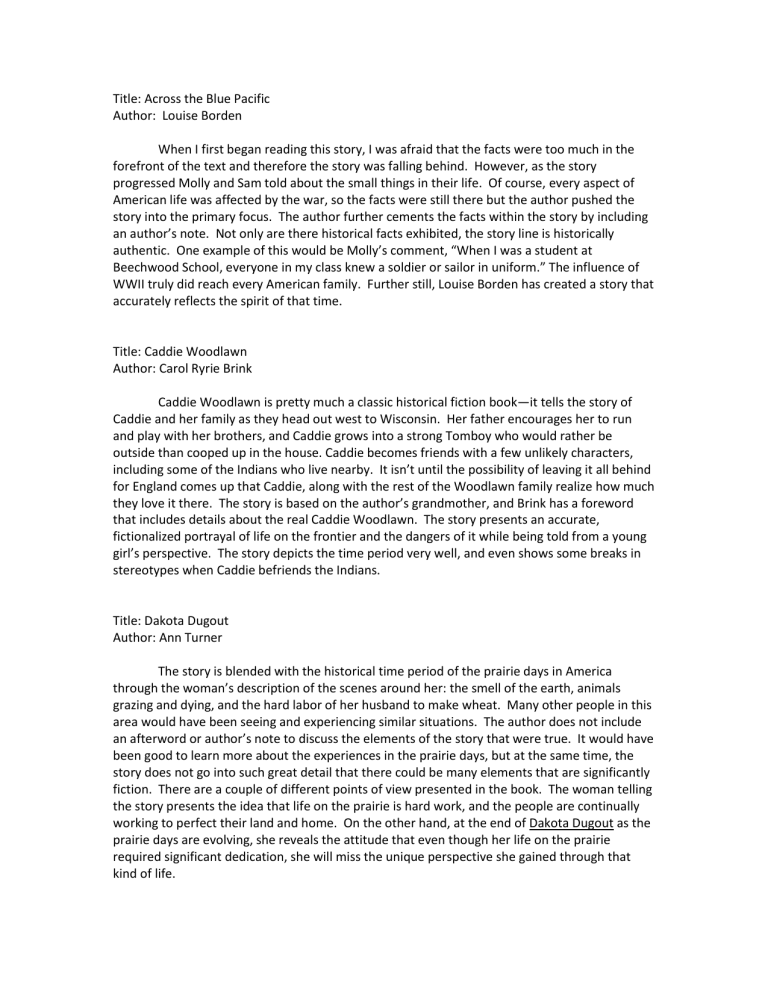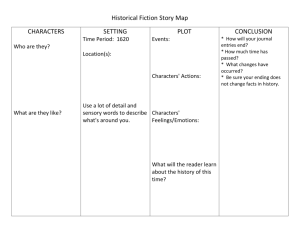Title: Across the Blue Pacific

Title: Across the Blue Pacific
Author: Louise Borden
When I first began reading this story, I was afraid that the facts were too much in the forefront of the text and therefore the story was falling behind. However, as the story progressed Molly and Sam told about the small things in their life. Of course, every aspect of
American life was affected by the war, so the facts were still there but the author pushed the story into the primary focus. The author further cements the facts within the story by including an author’s note. Not only are there historical facts exhibited, the story line is historically authentic. One example of this would be Molly’s comment, “When I was a student at
Beechwood School, everyone in my class knew a soldier or sailor in uniform.” The influence of
WWII truly did reach every American family. Further still, Louise Borden has created a story that accurately reflects the spirit of that time.
Title: Caddie Woodlawn
Author: Carol Ryrie Brink
Caddie Woodlawn is pretty much a classic historical fiction book—it tells the story of
Caddie and her family as they head out west to Wisconsin. Her father encourages her to run and play with her brothers, and Caddie grows into a strong Tomboy who would rather be outside than cooped up in the house. Caddie becomes friends with a few unlikely characters, including some of the Indians who live nearby. It isn’t until the possibility of leaving it all behind for England comes up that Caddie, along with the rest of the Woodlawn family realize how much they love it there. The story is based on the author’s grandmother, and Brink has a foreword that includes details about the real Caddie Woodlawn. The story presents an accurate, fictionalized portrayal of life on the frontier and the dangers of it while being told from a young girl’s perspective. The story depicts the time period very well, and even shows some breaks in stereotypes when Caddie befriends the Indians.
Title: Dakota Dugout
Author: Ann Turner
The story is blended with the historical time period of the prairie days in America through the woman’s description of the scenes around her: the smell of the earth, animals grazing and dying, and the hard labor of her husband to make wheat. Many other people in this area would have been seeing and experiencing similar situations. The author does not include an afterword or author’s note to discuss the elements of the story that were true. It would have been good to learn more about the experiences in the prairie days, but at the same time, the story does not go into such great detail that there could be many elements that are significantly fiction. There are a couple of different points of view presented in the book. The woman telling the story presents the idea that life on the prairie is hard work, and the people are continually working to perfect their land and home. On the other hand, at the end of Dakota Dugout as the prairie days are evolving, she reveals the attitude that even though her life on the prairie required significant dedication, she will miss the unique perspective she gained through that kind of life.
Title: Baseball Saved Us
Author: Ken Mochizuki
This book is about a boy and his family who are shipped to a holding camp during WWII because they were Japanese Americans. This particular story did not actually happen, but it potentially could have. It incorporates historical facts by talking about events that did happen in history, such as the Japanese being held in concentration camps. These events added to the plot of the story. Before the story begins, there is an author’s note that discusses the history of the war. It says the reason that the U.S. government sent the Japanese to these camps was because they didn’t know who was loyal to Japan still. We didn’t notice any evidence of contradiction or distortion of known events of history. The only point of view that is used is the view of the Japanese Americans that were in the camps at this time. The whole story is told from the eyes and mind of a little boy who was in a camp. The theme of accepting others provides insight and understanding for today’s problems as well. At the end of the story, the team cheers for the boy because he does well in the game even though he is a Japanese
American. This shows that there is more to a person than the color of his or her skin.
Title: Esperanza Rising
Author: Pam Munoz Ryan
This book tells a wonderful story of the struggles faced by one Mexican family. The story focuses on the strength of Esperanza and her journey through a very difficult time which ultimately matures her. The author blends fact with fiction very well by focusing mainly on
Esperanza’s voyage through childhood, while at the same time, introducing many aspects of her culture. There is an author’s note at the end of the book which provides a great amount of background information on Mexican-Californian immigration during the 1930s and 1940s.
Another positive aspect of this book is the use of many points of view offered in this book. These include the point of view of Esperanza, where everything seems unfair, the point of view of the adults in her family, where determination through adversity is most important, and the point of view of other Mexicans with regards to field work. This book definitely provides insight and understanding for today’s problems because the overall theme of the importance of family and determination can be applied to many aspects of life today.
Title: Lilly’s Crossing
Author: Patricia Reilly Giff
Lilly’s Crossing is a wonderful book that exemplifies the excellence that all Historical
Fiction books can reach for. The plot is supplied with rich and moving details while remaining simple and pleasureable to read. The information of the time period is representing accurately as the world that Lilly is emersed in but does not take over the story being told. Her summer experiences of coping with missing her father and her friend and developing a new friendship with Albert take the central role of the story while correctly depicting the truths about WWII and how it affected Americans. This was a very authentic and accurate book that reflected the values, norms, and spirit of WWII while presenting a story packed with universal themes and a heartwarming tale of friendship.
Title: Number the Stars
Author: Lois Lowry
In Lois Lowry’s Number the Stars fact is blended well with fiction because the action and emotion that is seen would naturally follow the events of the time period, so it seems real. The
Afterword provided at the end discusses what is authentic and what is from the author’s imagination. For example, the handkerchief that Annemarie delivered to her uncle on the boat was an actual tool used to keep the dogs from finding the hidden Jews and to get them to safety in Sweden. Even the exact dates and events surrounding the story were authentic as discussed in the Afterword. The story also provides different points of view. Annemarie is not Jewish, but her friend Ellen is, so we get to see and feel the emotions of both sides. The themes of selfsacrifice, standing up for what is right, and courage, provide insight and understanding for today’s problems as well as those of the past. Many non-Jews and Resistance fighters carried out these traits during that time, and they are certainly beneficial for us today, as well.
Title: Snow Treasure
Author: Marie McSwigan
Snow Treasure is a story of Norwegian children who smuggle gold out of the country past German soldiers during World War II, by hiding it in their sleds. The book is based on a true story, but the author has developed personalities and specific events to develop the plot. In a note, the author explains some of the changes from the truth which she incorporated into her version of the story: for example, she had her children take a much shorter sled ride then the actual children, who rode 35 miles on each trip! Since the book was originally published while the war was still going on, there was a lot of secrecy involved, and there is no way to tell exactly how accurate each detail is. The story is a unique one, since it tells a rarely heard tale from a unique perspective: that of Norwegian children in the midst of a German takeover.
Title: The Drinking Gourd
Author: F.N. Monjo
Slavery is obviously a real part of history. This story portrays the struggle of helping slaves escape to freedom through a fictional story and its characters. The author provides a good note at the end of the book which provides extra information about the slaves and the
Civil War. The historical events in the story are not contradictory or distorted because slavery and the Civil War actually happened. Slaves tried to escape to freedom and their masters would come looking for them. The book portrays these parts of slave history. The points of view of the boy named, Tommy, Tommy’s father, and the marshal who came to look for the slaves.
Tommy’s father would hide runaway slaves on their property while the marshal would come searching for them. Although the book does not really provide insight for today’s problems because slavery does no longer exist, it provides insight to the problems of the past, when slavery was in action. This story definitely portrays accuracy and authenticity. This book is historical fiction after all, and it reflects the slavery time-period due to its author’s accurate knowledge.
Title: The Friendship
Author: Mildred D. Taylor
In The Friendship by Mildred D. Taylor, fact is blended with fiction by depicting a time in the south when white people still disrespected black people. This also shows the different points of views during this time by showing Mr.B’s interaction with John Wallace and the black children’s interaction with John Wallace’s sons. At the end of the novel, there is a note from the author that gives her background on the subject and setting of the book. The theme of racial prejudices presented in the story, are still issues we face today.







